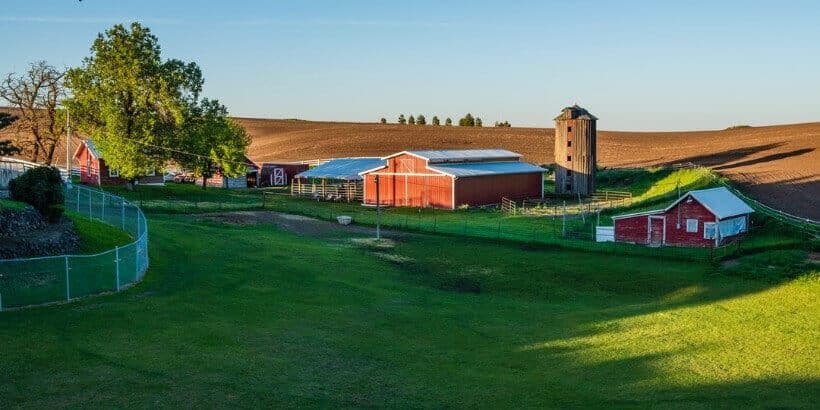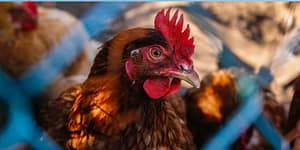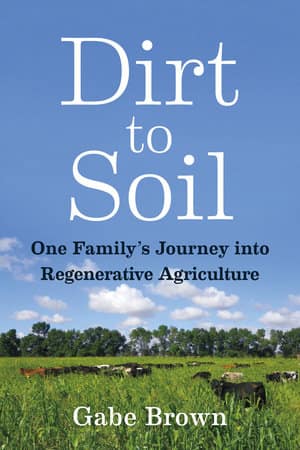Farming Against Nature

When you’re walking around the grocery store looking at all of the different vegetables, it’s probably hard to imagine that a century ago there was twice the amount of options to choose from. Hundreds of years of growing crops and infusing the soil with chemicals have depleted the dirt of the essential nutrients needed to nourish our food leaving us with far fewer crops than we once were accustomed to.
The following excerpt is from Dirt to Soil by Gabe Brown. It has been adapted for the web.
The changes in agricultural land in the United States due to the current production model are disturbing and sad.
I will use my ranch as an example. From historical archives we know that 140 years ago this part of North Dakota was covered with a diverse mix of cool- and warm-season grasses and broadleaved plants. European immigrants moved onto these prairies, bringing with them the plow. Diverse prairies soon were turned under with tillage which crushes, smashes, and pulverizes soil aggregates.
The tillage continued over many decades, and along with it came the widespread practice of monoculture grain production. Not just monocultures but fewer and fewer crop species as well. Where once grew more than one hundred species, now only a few grow. Overall, just fifteen crops supply approximately 90 percent of the plant-based foods we eat today! The early settlers ate a much more diverse diet than we do.
We can see the loss of species diversity in our commercial 
Soil scientist Dr. Wendy Taheri has recently discovered that many of today’s “new and improved” grain varieties do not have the ability to form symbiotic relationships with mycorrhizal fungi. These varieties are not able to take advantage of all the benefits that fungi have to offer. Breeders have been selecting for traits such as yield and not noticing that in the process other traits—such as the ability to form relationships with fungi—are lost.
It’s not that surprising, because plant breeders develop and propagate new varieties in sterile soil. The roots have never been exposed to mycorrhizal fungi, thus it goes unnoticed when a variety does not develop the ability to interact with fungi. Those varieties will be fully reliant on applied synthetic nutrients!
Loss of biodiversity has led to less nutrient cycling, which also equated to an increase in the use of synthetic fertilizer. This led to an increase in weeds (most weeds are high nitrogen users). An increase in weeds led to an increase in the use of herbicides. Many of the herbicides used today are chelators. Chelators bind to metal. Metals such as zinc, manganese, magnesium, iron, and copper. Can you guess where this is leading?
These are the same nutrients that plants need in order to ward off disease.
A lack of these nutrients can lead to a higher incidence of fungal diseases. An increase in fungal diseases leads to an increased use of fungicides. Fungicides are detrimental to soil biology and pollinators. Yes, pollinators! Recent studies show that fungicides, once thought to have no ill effects on bees, do have an impact. Scientists and corporate executives have to acknowledge that these compounds are having greater harmful effect than we realized. Farmers need to be educated on better methods, and consumers have to demand that the use of these fungicides is discontinued.
The lack of nutrients available to the plant also makes the plant more susceptible to pests.
An increase in pest pressure leads to an increased use of pesticides. Of course, the majority of pesticides are not pest specific, which means many beneficial insects will be killed also, including pollinator species, such as bees, that are needed to pollinate our crops. Almost all fruits and vegetables grown on conventional farms today are sprayed with copious amounts of insecticides. Is it any wonder that we have such a dysfunctional ecosystem?
From a livestock perspective, the goal of producing more and more pounds per animal led to raising animals in confinement.
Dairy cows and beef cattle were taken off pasture, where they once benefited the ecosystem by grazing living plants, thus cycling more carbon. Instead, today they are raised in confined quarters. Their diets were changed by the all-knowing authorities from forages to high-starch grains, affecting the animals’ health and longevity. Most dairy cows raised in confined high-production systems have a lifespan of less than four years! And the milk, cheeses, and other dairy products from this system are much less nutrient-dense, which is impacting human health as well.
The high starch rations fed to beef cattle in feedlots negatively impacts the lives of the animals, too, as well as the nutritional value of the beef itself. Take the example of omega fatty acids. Research has shown that foods with a lower ratio of omega-6 to omega-3 fatty acids are better for human health, and research has also shown that grass-fed beef has that low ratio, whereas grain-fed beef has a much higher ratio of omega-6 to omega-3 fatty acids.
The feedlot industry has nothing to do with the cattle business.
Feedlot operations are in business to market feed and pen space. They want cattle that will eat a lot of feed and take a long time to finish; that’s what is in their best financial interest. Does anyone truly believe that grazing animals prefer to be in a feedlot? Just open the gate and see what the animals choose.
The industry moved hogs, chickens, and turkeys into buildings in the ruse that the animals would be “better off.” Did anyone ask the animals? Back in 1983, when Shelly and I first moved to the farm, I took a part-time job at a nearby egg operation. My job duties included cleaning dead hens out of the cages. I started every morning at 6 a.m., kneeling on a trolley, pulling myself alongside the rows of cages, which housed over twenty thousand hens, elevated above tons of fecal material. Nine hens were crammed in a three-foot by three-foot cage, living their lives in an area where they could hardly turn around, never seeing or feeling the outdoors. I wondered about how they must feel, never having the opportunity to scratch through the leaves or catch a grasshopper. They had no opportunity to be a chicken! Right then and there I vowed never to have chickens, at least not chickens in confinement.
T
Are farmers and ranchers to blame for all this?
No, not entirely, but we need to take our fair share of the blame. The American public needs to take their part of the blame, as well, for allowing this to happen. Through their buying dollars, consumers have made the choice that they want this system, even as they choose to ignore the environmental degradation, the mistreatment of animals, and the overall decline in human health.
And think of what else this production model has caused. It has led to tighter and tighter margins for producers. Lower margins mean producers must farm more and more land to make ends meet. Farm sizes increase, leaving fewer farms overall and fewer people operating the land. In other words, this production model has also led to the demise of many of our small towns.
Consider these facts
- Three companies control over 75 percent of the agrochemical industry.
- Three companies supply over 90 percent of the breeding stock of layers, broilers, turkeys, and pigs.
- Four firms control between half to three-quarters of all animal slaughter, depending on species.
- Five companies control over 50 percent of the farm machinery market.
Paul Aackley, a longtime friend and regenerative Iowa farmer, summarized the ramifications of the current production model.
Paul writes, “From memory and records since 1949: From where I sit at this computer, there were four occupied farmsteads along the mile of road to the north and a schoolhouse at the end of that mile, to the south within half a mile was the schoolhouse where I and four others started kindergarten in the fall of 1950 (one later became head of neurosurgery at Yale) and an occupied farmstead within the next half mile and three-quarter mile east and west. Even tenant farmers had a connection to the land, not as strong as owner-operators, but a connection. I don’t think anyone had figured out how to drain our side hill seeps (wet area) with tile. That came during the decade, but most didn’t think they could afford the cost for another fifteen to twenty years. The local weekly paper always had at least one farm sale during the winter and early spring months from the mid-1950s until the mid-60s. There was cost-share assistance to apply lime and seed alfalfa/grass in the early ’50s. This all began to change during the ’60s. NPK became readily available. Atrazine for corn and Amiben for soybeans were introduced. Out-of-county or out-of-state investors began to purchase land that had been marginal, tile out wet areas and clear trees and crop-share or cash-rent it for row crops. Profit from the rent or profit from the inflating land value drove the change. I remember one day watching a 24-row planter work on some adjoining land and realized what the American Indian must have felt when the white man showed up. The land ethic gathered dust on a shelf somewhere. Change (technology) came faster and with more force (profit) than humans could handle intelligently.”
Well said, Paul.
Recommended Reads
Recent Articles
Beavers are ecological and hydrological Swiss Army knives. Capable of tackling just about any landscape-scale problem you might confront.
Read MoreAside from the sheer pleasure of telling your friends, straight-faced, that you maintain your garden using something called a “chicken tractor,” there are a slew of other benefits to working the land with a few of your animal friends. Getting rid of pests without chemicals, for one; letting them do the work of weeding and…
Read MoreIf the idea of running a vegetable farm sounds daunting, you’re not alone. What can you do to simplify techniques and reduce expenses? Where do you even begin?
Read MoreWhen you’re walking around the grocery store looking at the vegetables, it’s probably hard to imagine that a century ago there was twice the amount of options.
Read MoreIf you love tomatoes, you probably already know just how many varieties of these summertime staples there are. But do you know what makes each one unique?
Read More








